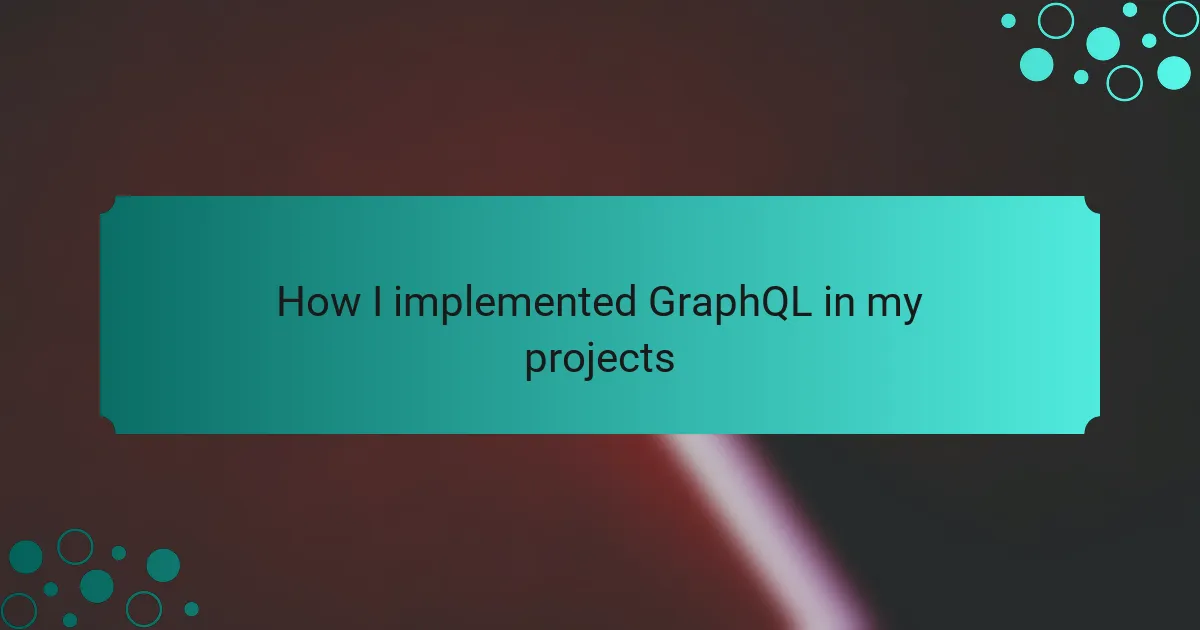Key takeaways
- GraphQL simplifies data fetching by allowing clients to request exactly the data they need in a single query, eliminating issues of over-fetching and under-fetching.
- Strong typing and a clear schema enhance predictability, reduce bugs, and improve collaboration among developers.
- Integration of GraphQL with tools like Apollo Server and monitoring tools can significantly improve performance and developer experience.
- Attention to query structure and schema design is crucial for optimal performance and maintainability. Utilizing fragments can help reduce redundancy and keep code clean.

Introduction to GraphQL
GraphQL has truly transformed the way I approach data fetching in my projects. Unlike traditional REST APIs, which often require multiple endpoints for different resources, GraphQL allows me to retrieve all the data I need in a single request. This not only simplifies my code but also enhances performance, making for a smoother user experience.
When I first introduced GraphQL to my workflow, I found its flexibility refreshing. I could query exactly what I wanted, no more, no less. It felt like a breath of fresh air compared to the cumbersome nature of REST, where I often faced over-fetching or under-fetching problems.
Here’s a quick comparison highlighting the differences between GraphQL and REST:
| Feature | GraphQL | REST |
|---|---|---|
| Data Fetching | Single query for multiple resources | Multiple endpoints for different resources |
| Over-fetching/Under-fetching | Eliminated | Common issues |
| Versioning | No versioning needed | Versioning may be required |
| Response Structure | Client defines shape of response | Server defines structure |
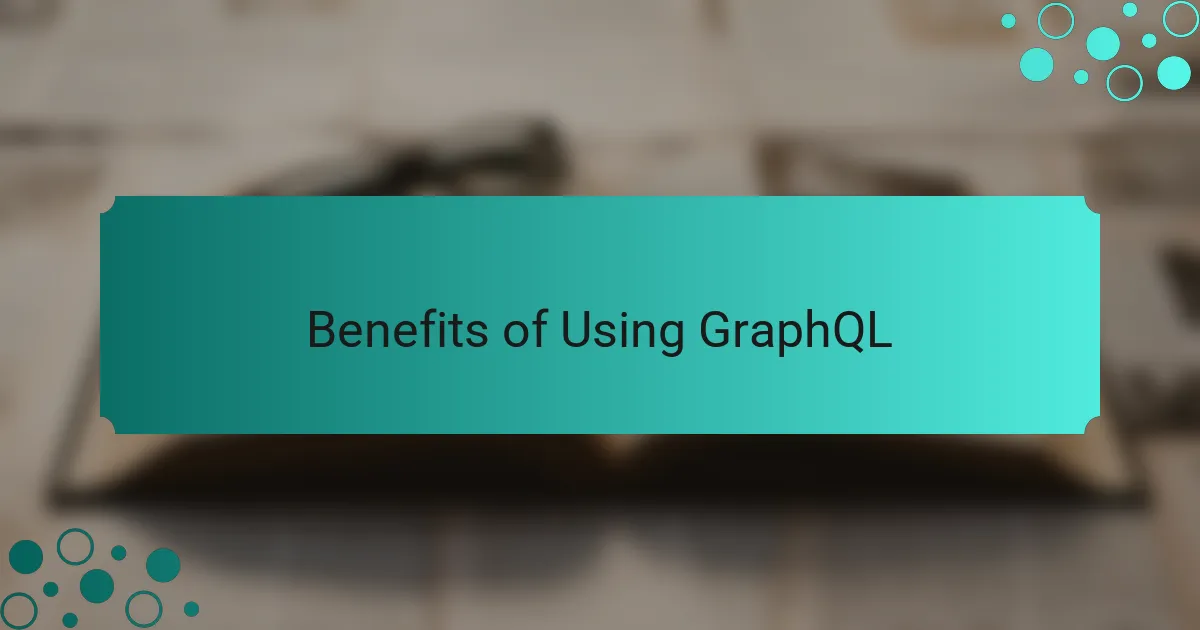
Benefits of Using GraphQL
One of the standout benefits of using GraphQL is its flexibility in handling data requests. Unlike REST, where you often have to over-fetch or under-fetch data, GraphQL allows you to specify exactly what you need. I remember working on a project where we were constantly battling with inefficient API calls; switching to GraphQL not only simplified our requests but significantly improved the overall performance.
Another significant advantage is the strong typing system that comes with GraphQL. This feature ensures that your queries and responses are predictable, reducing the likelihood of bugs. In my experience, this not only boosts developer confidence but also makes collaboration among team members much smoother, as everyone knows exactly what types of data they are dealing with.
Here are some key benefits of using GraphQL:
- Efficiency in Data Retrieval: Request only the data needed in a single query.
- Strongly Typed Schema: Predictable queries lead to fewer runtime errors.
- Ease of Maintenance: Changes to the schema are easier to manage, enhancing productivity.
- Powerful Developer Tools: Introspection and auto-completion improve the developer experience.
- Versionless APIs: No need for versioning; clients can request a shape of the data they require.

Setting Up a GraphQL Environment
When I set up my GraphQL environment, the first step was choosing the right server framework. I opted for Apollo Server, which made integrating GraphQL with my existing projects seamless. I remember the thrill of seeing my first GraphQL schema come to life; it felt like I was building a solid foundation for something powerful.
Next, I had to define my schema using the GraphQL schema definition language (SDL). This step was particularly satisfying for me, as it allowed me to determine the exact data structure and types that my API would handle. I can’t stress enough how liberating it was to map out the precise fields and relationships I needed, which felt like an artist planning a masterpiece.
Finally, I configured my resolvers to fetch the data. This is where the magic truly happens. I recall the moment when everything clicked — my client could request data with the specific shape I designed, and I no longer had to worry about over-fetching. It felt like discovering a new superpower, unlocking a world where I could deliver exactly what was needed, efficiently and elegantly.
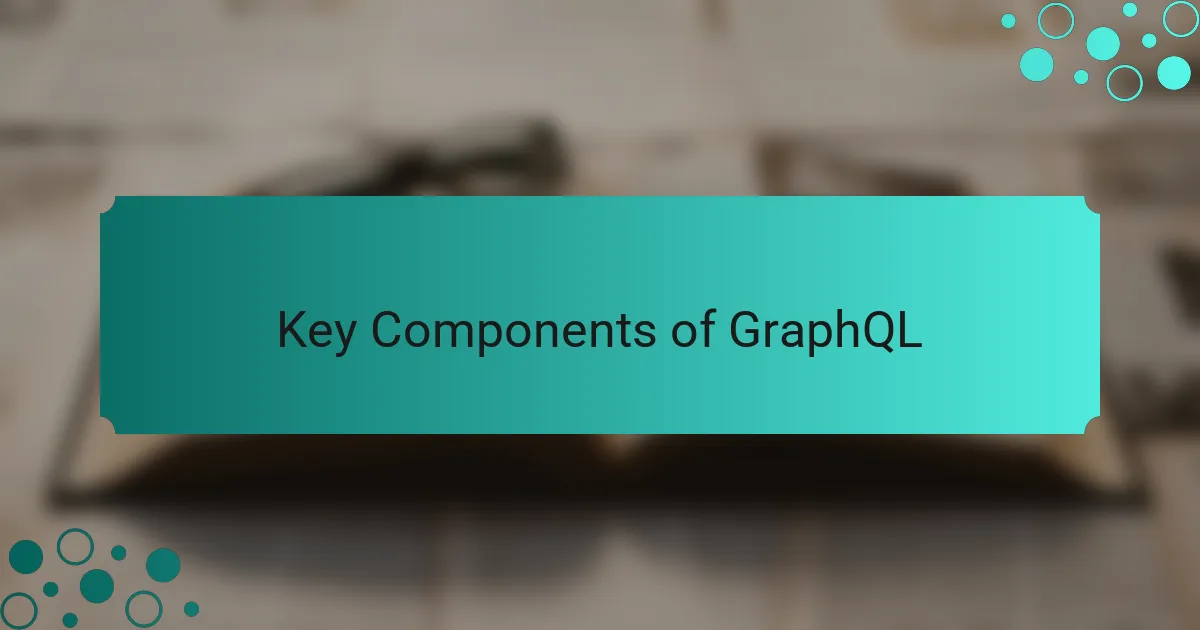
Key Components of GraphQL
When I first dove into GraphQL, I was fascinated by its flexibility and efficiency compared to REST APIs. It allows clients to request exactly the data they need, nothing more, nothing less, which truly minimizes over-fetching and under-fetching. I remember the initial thrill when I realized how easily I could tailor requests, which made my applications more responsive and user-friendly.
Exploring GraphQL, I discovered several key components that shape its structure and functionality. Understanding these elements not only enhanced my projects but also significantly improved my coding practices.
- Queries: The way to request specific data from the server. I often compare this to ordering from a menu, where you choose exactly what you want.
- Mutations: These allow clients to modify server-side data. They’re essentially the equivalent of placing an order after selecting your meal.
- Schemas: The blueprint of your API, detailing what queries and mutations are possible. Crafting an effective schema was like laying the groundwork for a successful project.
- Resolvers: Functions that define how to fetch the data for a specific query. In my experience, good resolvers make all the difference in the response time and reliability.
- Subscriptions: For real-time communication, these are invaluable. I felt a rush when implementing them, as they opened up new possibilities for interactive user experiences.
Delving into these components made me truly appreciate the power and potential of GraphQL.
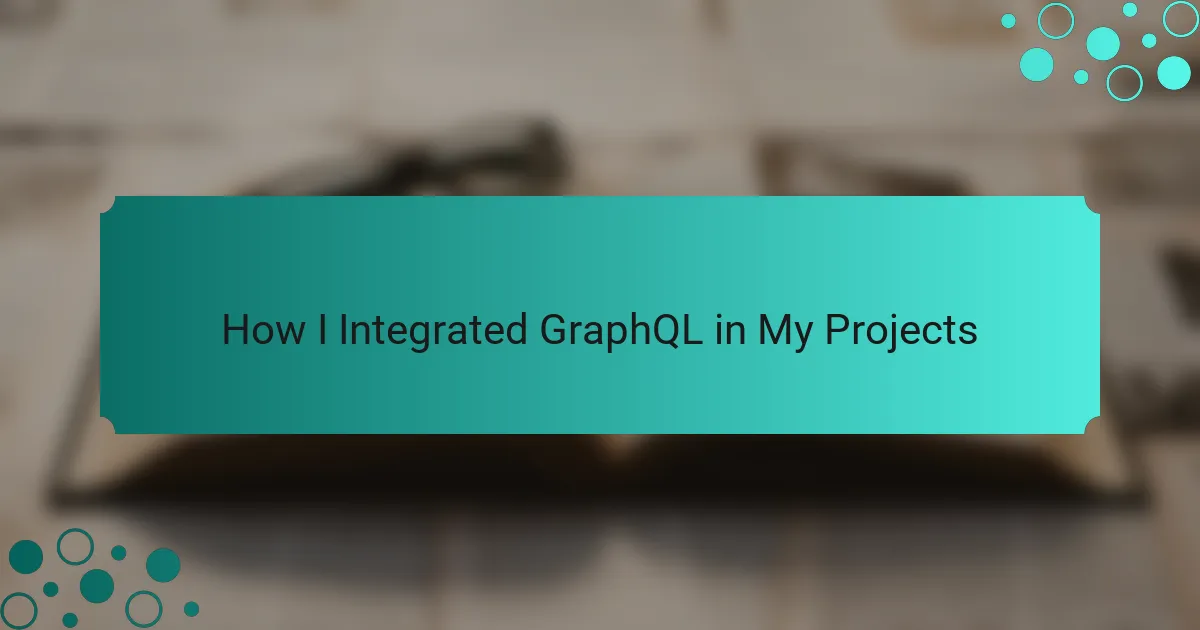
How I Integrated GraphQL in My Projects
When it came to integrating GraphQL into my projects, I was initially drawn to its efficiency. The ability to request only the data I needed felt like a breath of fresh air compared to traditional REST APIs. One of my most memorable experiences was during a project where I replaced a convoluted API with GraphQL. It was like turning on a light in a dark room; everything became clearer and more manageable.
The process itself was not without its challenges, though. I encountered some hurdles, especially while defining schemas and resolving types. But each struggled moment taught me something new, and the satisfaction I felt when things started clicking was incredibly rewarding.
Here’s a quick list of steps I followed that made the integration smoother:
- Set up Apollo Client for managing queries and mutations.
- Defined a clear schema to outline the types and relationships.
- Utilized GraphiQL for testing queries during development.
- Implemented error handling to gracefully manage issues.
- Optimized query performance with pagination as my data set grew.
Embracing GraphQL transformed my projects and, ultimately, my approach to API design.
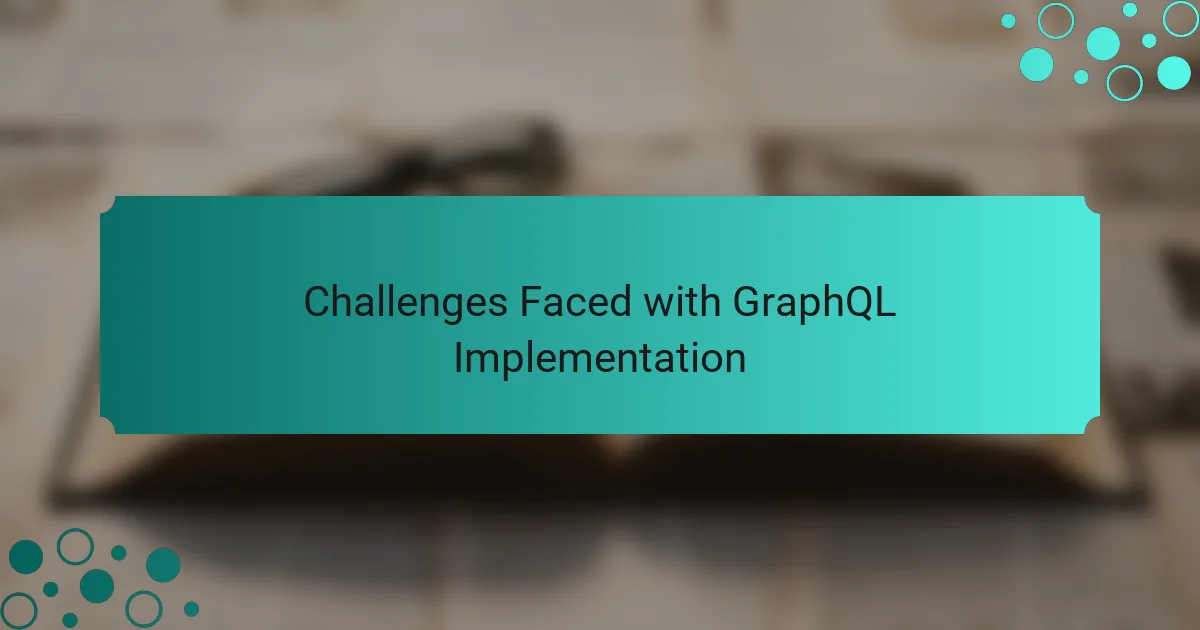
Challenges Faced with GraphQL Implementation
When I first ventured into implementing GraphQL, I encountered a few hurdles that were quite unexpected. One major challenge was the steep learning curve; transitioning from REST APIs to GraphQL required a shift in my thinking. It felt overwhelming at times, especially when I grappled with concepts like queries, mutations, and subscriptions. I vividly remember spending hours poring over documentation just trying to understand how to structure my queries efficiently.
Another challenge was optimizing performance. While GraphQL offers flexibility by allowing clients to request only the data they need, I discovered that poorly structured queries could still lead to performance hits. In one instance, I had to rethink my data-fetching strategy after realizing that a single query was triggering multiple database calls, resulting in slower response times. Balancing the power of GraphQL with the need for efficiency was a real eye-opener.
- Navigating the transition from REST to GraphQL felt daunting.
- Understanding the intricacies of queries, mutations, and subscriptions took considerable time.
- Structuring queries for optimal performance posed significant challenges.
- Monitoring and debugging GraphQL queries required new tools and approaches.
- Managing overly complex schemas resulted in confusion and increased maintenance efforts.
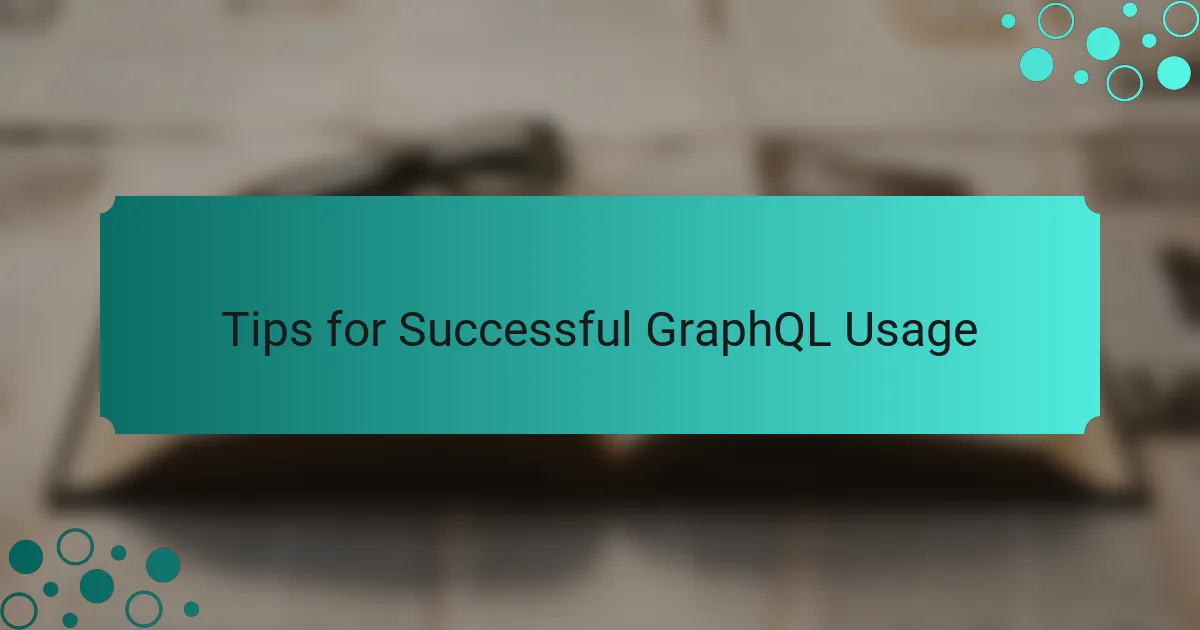
Tips for Successful GraphQL Usage
When using GraphQL, a crucial tip is to ensure your schema is both clear and well-structured. I’ve learned that taking the time to design your schema thoughtfully pays off immensely down the road. For instance, when I first created a schema with too many nested relationships, it quickly became cumbersome. Simplifying the structure not only helped with readability but also made it easier for my team to collaborate effectively.
Another practice I highly recommend is leveraging fragments for reusability. There’s something gratifying about writing a query once and reusing it in various parts of your application. I remember implementing fragments in a project, and it felt like discovering a shortcut that saved me hours of coding. This approach minimizes redundancy and helps keep your code clean and maintainable.
Don’t underestimate the importance of monitoring your queries. In my experience, tools like Apollo DevTools have been invaluable. They allow me to see how my queries perform and identify any potential bottlenecks. Have you ever been frustrated by slow responses in your applications? I certainly have, and this kind of monitoring has been a game-changer, enabling me to optimize those queries for a smoother user experience.
